During the Lenten season of prayer, fasting and almsgiving, all are invited to join our Lenten video series.
Beginning on Ash Wednesday and continuing each Friday of Lent, this series will offer a Gospel reading proclaimed by a priest from the diverse communities supported by our donors, including Alaska, Appalachia, Puerto Rico and more.
Additionally, each video will include a homily from our president, Father Jack Wall.
Finally, you can sign up to receive a meatless dish recipe that comes from the region of each week’s reading. This recipe will be sent a few days ahead of each video.
Jump to each week’s Gospel readings and recipes!
Ash Wednesday recipes | Ash Wednesday Gospel reading | First Friday of Lent recipe | First Friday of Lent Gospel reading | Second Friday of Lent recipe | Second Friday of Lent Gospel reading | Third Friday of Lent recipe | Third Friday of Lent Gospel reading | Fourth Friday of Lent recipe | Fourth Friday of Lent Gospel reading | Fifth Friday of Lent recipes | Fifth Friday of Lent Gospel reading | Sixth Friday of Lent recipe | Sixth Friday of Lent Gospel reading
Sign up to receive this series in your inbox!
Or, text LENT22 to 50155 to receive the series via text.
Sixth Friday of Lent
Gospel reading | Father Jason Vidrine | Diocese of Lafayette, Louisiana
Father Jason Vidrine from the Diocese of Lafayette, Louisiana proclaims today’s Gospel for the Sixth Friday of Lent, the final reading in our Live the Lenten Journey series. Through the generosity of our donors, we strengthen the vibrant Catholic faith communities of this diocese by supporting parishes, ministries and seminarian education.
Ahead of the Sixth Friday of Lent, we are sharing the recipe below from the Diocese of Lafayette, Louisiana.
Meatless recipe for the Sixth Friday of Lent: Diocese of Lafayette, Louisiana
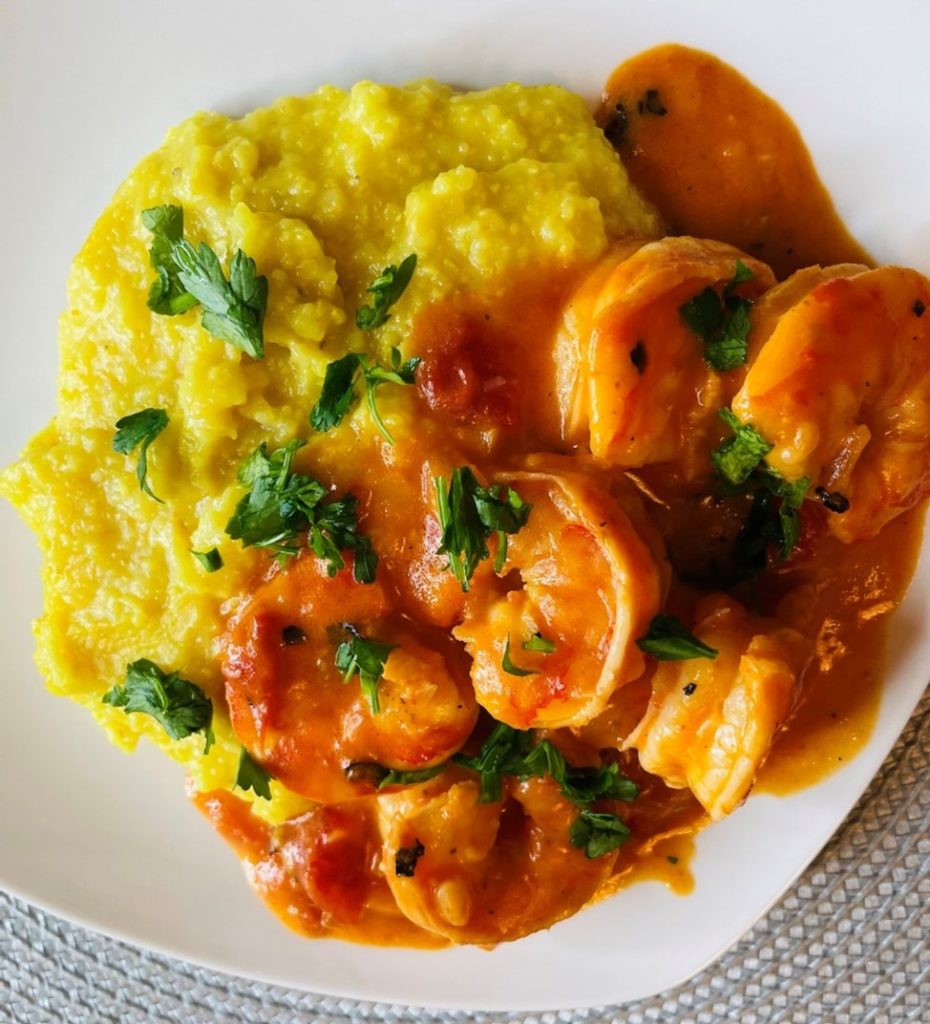
Shrimp and grits is a staple dish in the Extension-supported Diocese of Lafayette, Louisiana, and across the American South. It’s the reason why the region is sometimes referred to as the “Grits Belt.”
Originally an African dish of ground maize and shellfish, shrimp and grits migrated with people who were enslaved in plantation kitchens. Today it is popular across the South, and because of its versatility, there are multiple variations of the dish found throughout the country depending on local ingredients.
No matter where you’re from, this meatless masterpiece shines as a delicious Friday Lenten meal.
Prep: 15 mins
Cook: 45 mins
Total: 60 mins
Servings: 4
Ingredients for the Grits:
- ¾ cup grits
- ¼ teaspoon salt
- 6 ounces cheddar cheese, grated
- 3 tablespoons butter
Ingredients for the Shrimp:
- 4 tablespoons butter
- ¾ cup chopped onion
- ½ cup chopped green bell pepper
- 2 garlic cloves, minced
- 1 cup diced fire-roasted canned tomatoes.
- ½ teaspoon dried thyme
- 1 tablespoon flour
- 1 pound medium to large raw shrimp, shelled (reserve shells for stock)
- ½ to 1 cup shrimp stock (see note)
- 1 tablespoon tomato paste
- ⅓ cup heavy cream
- 2 teaspoons Worcestershire sauce
- 2 dashes Tabasco sauce
- Salt and pepper to taste
- 2 tablespoons chopped fresh parsley
Directions
Step 1: For the grits, bring 3 1/2 cups water to a boil and stir in the grits.
Step 2: Reduce heat to low, cover and cook for 15 to 20 minutes, until the grits are tender, and the liquid has been absorbed.
Step 3: Remove from heat, add the salt, cheese and butter, and stir until melted. Keep warm.
Step 4: For the shrimp, melt the butter in a large skillet over medium heat and sauté the onion, pepper, and garlic until softened, about 3 minutes.
Step 5: Add the tomatoes with its juice and thyme; bring to a simmer. Cook for 2 or 3 minutes. Sprinkle with flour and stir well.
Step 6: Add 1/2 cup stock and cook for 2 to 3 minutes more. Add the tomato paste and stir until blended. Add the cream, Worcestershire and Tabasco and more stock if needed to make a spoonable sauce that will generously coat the shrimp.
Step 7: Add the shrimp and stir constantly until they begin to turn pink, about 2 minutes. Heat thoroughly, being careful not to let it come to a boil. Taste for salt and pepper.
Step 8: Place a portion of grits in the center of each plate and spoon shrimp over or around it. Sprinkle with parsley.
Tip: To make shrimp stock, combine shrimp shells and 2 cups water and boil until the liquid is reduced by half. Strain.
Fifth Friday of Lent
Gospel reading | Father Isidro Ogumoro | Diocese of Chalan Kanoa in the Northern Mariana Islands
Father Isidro Ogumoro proclaims the Gospel for the fifth Friday of Lent. He joins us from the Diocese of Chalan Kanoa in the Northern Mariana Islands, a U.S. protectorate located thousands of miles away across the Pacific Ocean.
Father Ogumoro is pastor of San Roque Parish, which we helped build in 1972. Our donors support the diverse and faith-filled communities on these beautiful islands.
Meatless recipes for Fifth Friday of Lent: Diocese of Chalan Kanoa in the Northern Mariana Islands
The Northern Mariana Islands is a U.S. territory in the Pacific that is home to the Extension-supported Diocese of Chalan Kanoa. The diocese shared two meatless recipes with us that can be prepared ahead of the fifth Friday of Lent: Eskabeche and Titiyas.
Recipe 1: Eskabeche
Eskabeche comes from the Diocese of Chalan Kanoa, located in the Northern Mariana Islands. These islands were first inhabited centuries ago by the Chamorro people, who have common ancestors with the native people of the Philippines.
Eskabeche is popular among the Chamorro people and is made with fried fish and vegetables. This dish is very similar to the original Spanish version, except for the use of turmeric (or ginger) instead of paprika as the main flavoring (and coloring) ingredient. This traditional dish is something families eat during the Fridays of Lent, as well as for Christmas Eve Day.
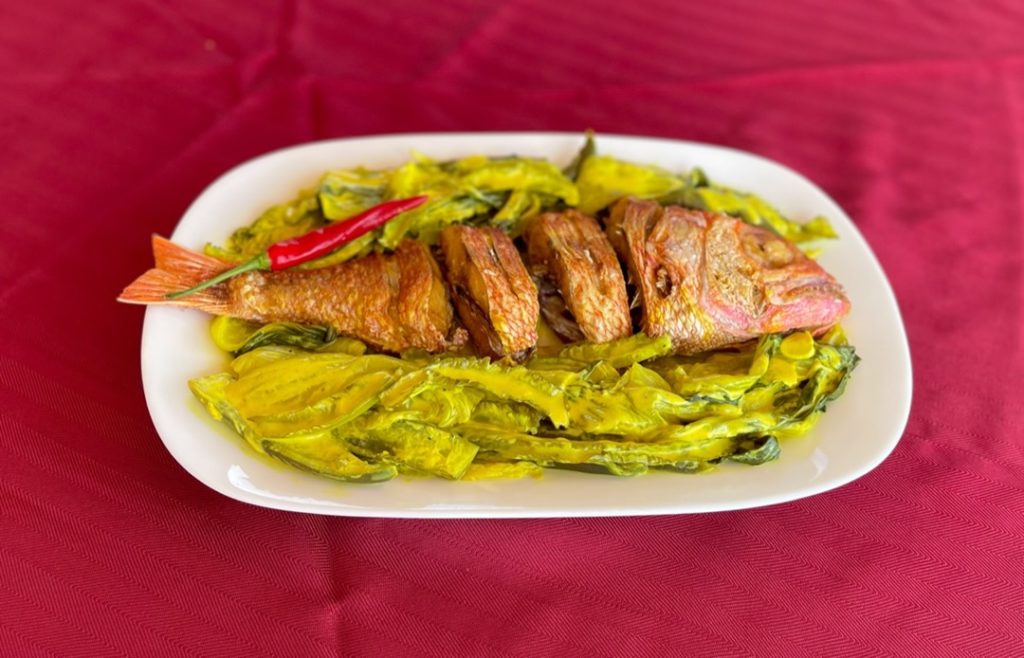
Prep: 30 mins
Cook: 15 mins
Total: 45 mins
Servings: 4
Ingredients
- 1 medium size fish or 2 smaller ones (can be any white fish like tilapa, parrot fish, or orange roughy)
- ½ cup oil for frying fish
- Either 1 large eggplant or 4 medium long (Japanese or Chinese) eggplants, sliced lengthwise, 1/4 inch thick
- ½ pound pechay (can be substituted with any favorite veggies, like string beans, tomato wedges, wing beans or bell peppers.)
- ¼ of a Chinese cabbage
- A few wing beans or string beans
- 1 can coconut milk
- 1 teaspoon salt
- 2 tablespoon vinegar
- 1-½ teaspoon turmeric powder
- 1 pinch ground black pepper
- 3 garlic cloves
- ½ yellow onion
- 2 tablespoon olive oil
- Some red whole peppers for garnish
Step 1: Rub little salt on fish and fry until golden brown. Set aside.
Step 2: Slice the eggplants, pechay, cabbage, and beans and blanch in boiling water. Set aside.
Step 3: Mix coconut milk, salt, vinegar, turmeric powder, black pepper in a separate bowl.
Step 4: Sautee garlic and onions in heated olive oil in a pot.
Step 5:Pour coconut milk mixture into the heated pot and boil for a minute while stirring.
Step 6: Arrange fish and the blanched vegetables in a dish.
Step 7: Pour sauce evenly over the vegetables.
Step 8: Garnish with a whole red pepper, then serve.
Recipe 2: Titiyas
Spanish influence is apparent in several aspects of Chamorro cuisine. Titiyas are a Chamorro adaptation of tortillas. Titiyas (pronounced “ti-ti-djas”), derived from the Spanish word “tortilla,” is a flatbread made from harina (flour, sweetened) or mai’es (corn). Titiyas månha, or wheat flour mixed with coconut milk and sometimes with soft meat of the young coconut, is a local favorite. Many households have members who specialize in making titiyas for family consumption, especially during the Lenten season!
This recipe creates many servings and is best suited for large gatherings.
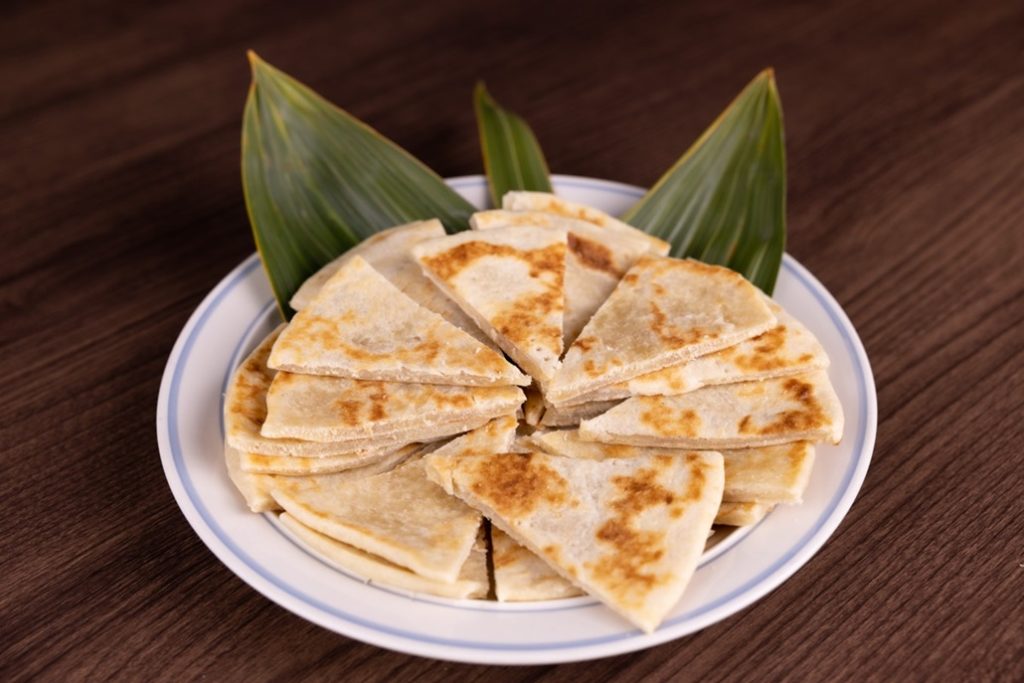
Prep: 30 mins
Cook: 30 mins
Total: 60 mins
Servings: 60
Ingredients
- 12 fresh coconuts (equivalent of 6 cups of coconut milk, if you prefer to purchase canned milk)
- 5 pounds flour
- ½ kilogram sugar
- 2 tablespoon baking soda
Instructions
Step 1: Husk and grind the coconuts. Squeeze and strain the milk out of the ground coconut meat. (Traditionally, we grate the coconut, since every home must have a manual coconut grater. Nowadays, many will go for the canned coconut milk for faster and easier prep, since they are very available at stores, but of course the fresh grated coconut stands out better in taste!)
Step 2: Combine the flour, sugar, and baking soda into a large pan or bowl. Mix well.
Step 3: Pour the coconut milk into the pan and mix until it becomes a soft dough.
Step 4: Cut the dough into handful sizes. Using a rolling pin flatten the dough into 8 to 12-inch round shapes. Poke the flattened dough with fork to prevent bubbling during the cooking process.
Step 5: Place the flat dough into a skillet over low heat to cook. Cook until flour rises and you can see brown patches on surface (about 3 minutes). Turn on each side.
Step 6: Cut into triangular pieces and serve.
Fourth Friday of Lent
Gospel reading | Father Kevin Cintrón | Diocese of Caguas, Puerto Rico
The Gospel reading for the Fourth Friday of Lent comes from Father Kevin Cintrón, pastor of San Gerardo Mayela Chapel in the Diocese of Caguas. Catholic Extension Society helped build this beautiful and humble church in 2011 and continues to strengthen faith communities across the island. As we celebrate the Feast of the Annunciation today, the angel’s message puts all of humanity on notice about God’s undying love for us. Through their generosity, our supporters are also helping carry and incarnate God’s message of love to the farthest reaches of our country.
Ahead of the Fourth Friday of Lent, we are sharing the recipe below from the Diocese of Caguas, Puerto Rico.
Meatless recipe for Fourth Friday of Lent: Diocese of Caguas, Puerto Rico
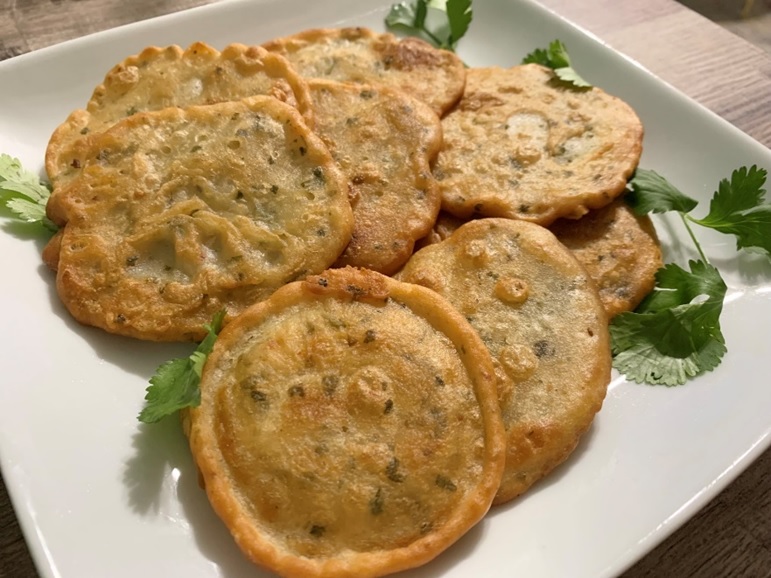
Bacalaitos (BACK-AL-EYE-IT-OZ) (fried cod fritters) are a revered food in Puerto Rico for all seasons and occasions. At almost every Catholic church event, Bacalaitos are sold to help raise funds for the local parish given how widely popular they are. They can easily be eaten while walking in the town square or enjoyed at a sit-down meal. Enhance your Lenten fish fries this year by adding this amazing Puerto Rican classic to your rotation of fried “surf.”
Ingredients:
- 1 ½ lb of salted cod (or salted pollock)
- 1 ½ cups of flour
- 1 teaspoon of baking powder
- 1 ½ cups of water
- 1 pinch of ground pepper
- 2 garlic cloves (finely chopped)
- 3 long-leaf coriander (cilantro) (finely chopped)
- 1 small, sweet cachucha pepper (finely chopped)
- ½ teaspoon of fresh oregano (finely chopped)
- Vegetable oil (for frying)
Note: Please make sure the cod has no spines as they could impose a serious health risk.
Instructions:
Step 1: In a bowl, place the salted cod and let it rest in cold water for at least 2 hrs.
Step 2: Drain water and taste to make sure it’s not extremely salty. If it is, place it in fresh, cold water and let rest for 2 more hrs.
Step 3: Drain water and manually crumble the cod apart to small pieces. Make sure you remove all spines.
Step 4: Mix the flour with all ingredients (including the cod). Mix well until you have a pancake-like mixture. More Water = thick mixture = thick cod fritter.
Step 5: Using an iron, aluminum pot or frying skillet, add about ¼ inch of vegetable oil over medium-high heat. The oil should be hot and just enough to cover one full side of each fritter, otherwise the fritter will break apart or soak in too much oil and not be as tasteful.
Step 6: Using a big, metal (frying) spoon, add about ¼ cup of the mixture to the hot oil.
Step 7: Let it toast on one side and carefully turn over (kind of like a pancake).
Step 8: Remove from the oil and let it drain the excess fat by placing on paper towel. You may also use wooden sticks to hang and drain.
Third Friday of Lent
Gospel reading | Father César Izquierdo | Diocese of Yakima, Washington
Joining us from the Diocese of Yakima, Washington, Father César Izquierdo proclaims the Gospel reading for the third Friday of Lent. Catholic Extension Society supported Father Izquierdo’s seminarian education during his journey to the priesthood, and support Hispanic and migrant ministries that build up faith and family in this rural, agricultural region.
Ahead of the Third Friday of Lent, we are sharing the recipe below from the Diocese of Yakima, Washington.
Meatless recipe for Third Friday of Lent: Chiles Rellenos
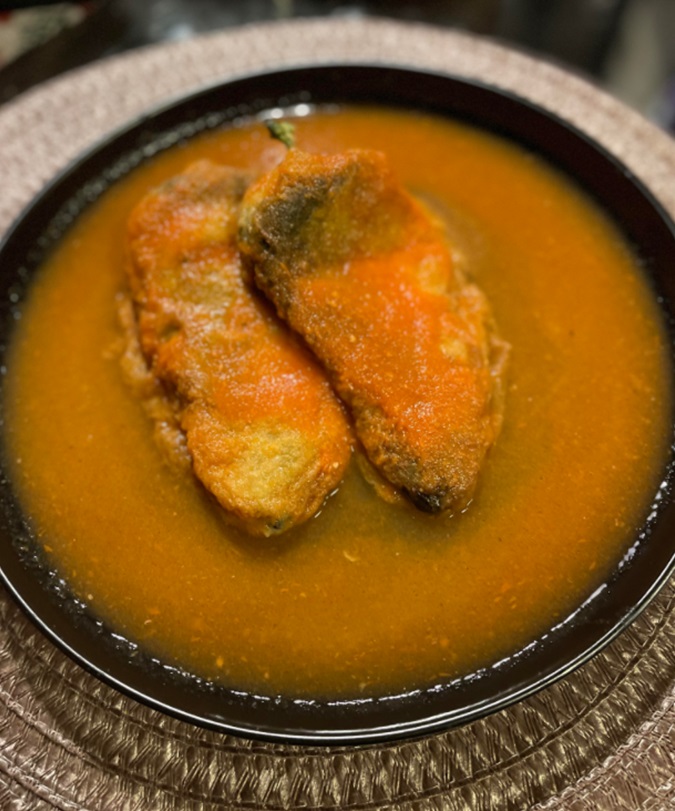
Chiles rellenos [ray-n-ohs] (stuffed chile peppers) are a flavor-filled and textural sensation! They begin with the large “chile poblano,” named after the State of Puebla in central Mexico, which is incidentally also where the holiday Cinco de Mayo has its origins when the Mexican forces defeated French occupiers. If you are concerned about heat level, don’t be. These peppers are not spicy. Filled with cheese and fried in a light batter, they are the perfect companion to meatless Fridays, and well worth adding to your Lenten recipe repertoire.
Prep: 30 minutes
Cook: 10 minutes
Additional: 5 minutes
Total: 45 minutes
Servings: 4
Ingredients:
- 4 poblano peppers
- ½ lb of mozzarella cheese
- 6 tomatoes
- ¼ onion
- 2 cups of water
- 1 garlic
- 1 cup and 1 tablespoon of flour
- 3 spoon fools of oil
- 1 tablespoon of Chicken Flavor Bouillon (Knorr Brand)
- ½ tablespoon of salt
- 3 eggs
- 4 toothpicks
- 1 cup of oil
Directions
Step 1: Set pan on high, place the four peppers, and turn them as they begin to look black to ensure they’re cooked evenly.
Step 2: Put the peppers in a plastic bag, make a knot in the bag and leave for 5 minutes. This will allow the peppers to be easier to peel. Once the peppers are peeled, cut and open the pepper, take the seeds out, and rinse the peppers in water.
Step 3: Pat down with a napkin to dry the peppers if needed. Add a ¼ cup of cheese inside the peppers and put a toothpick in the middle of the pepper. This will help prevent the cheese from coming out.
Step 4: Separate the egg yolk from egg whites. Blend the egg whites for about 3 minutes on high with the mixer until the egg whites have a stiff peak form. Add in the yolks and mix for 2 minutes.
Step 5: Heat up a pan on high to ensure the oil is hot. Put flour on a plate/bowl, cover the peppers in flour, and then dip into the egg mixture to coat.
Step 6: Lower the temperature of the pan. Fry the peppers until browned on each side for 2 minutes.
Step 7: To make the soup for the peppers, cut six tomatoes into halves or quarters, chop ¼ of onion, and add 2 cups of water. Blend for 1 minute.
Step 8: In a hot pot, add 3 spoonfuls of oil and ensure the oil is hot and add 1 tablespoon of flour and mix well (make sure it doesn’t turn brown.) Once it is mixed, add the tomato that was blended into the pot and stir at medium temperature for 3 minutes.
Step 9: Add 1 tablespoon of the Chicken flavor Bouillon (Knorr brand) and ½ tablespoon of salt to the soup, and 2 cups of water and mix. Once the soup is hot, add the peppers to the tomato soup.
Second Friday of Lent
Gospel Reading | Father Patrick McGuire, SMA | Diocese of Gallup, New Mexico
Father Patrick McGuire, SMA, the Gospel reading for the second Friday of Lent. Our donors support his salary, helping him serve the Zuni people in the Diocese of Gallup, New Mexico. Beloved in the community, Father McGuire offers hope and strength in a ministry that celebrates Zuni culture and the Catholic faith.
Ahead of the Second Friday of Lent, we are sharing the recipe below from the Diocese of Gallup, New Mexico.
Meatless recipe for Second Friday of Lent: Navajo Fry Bread
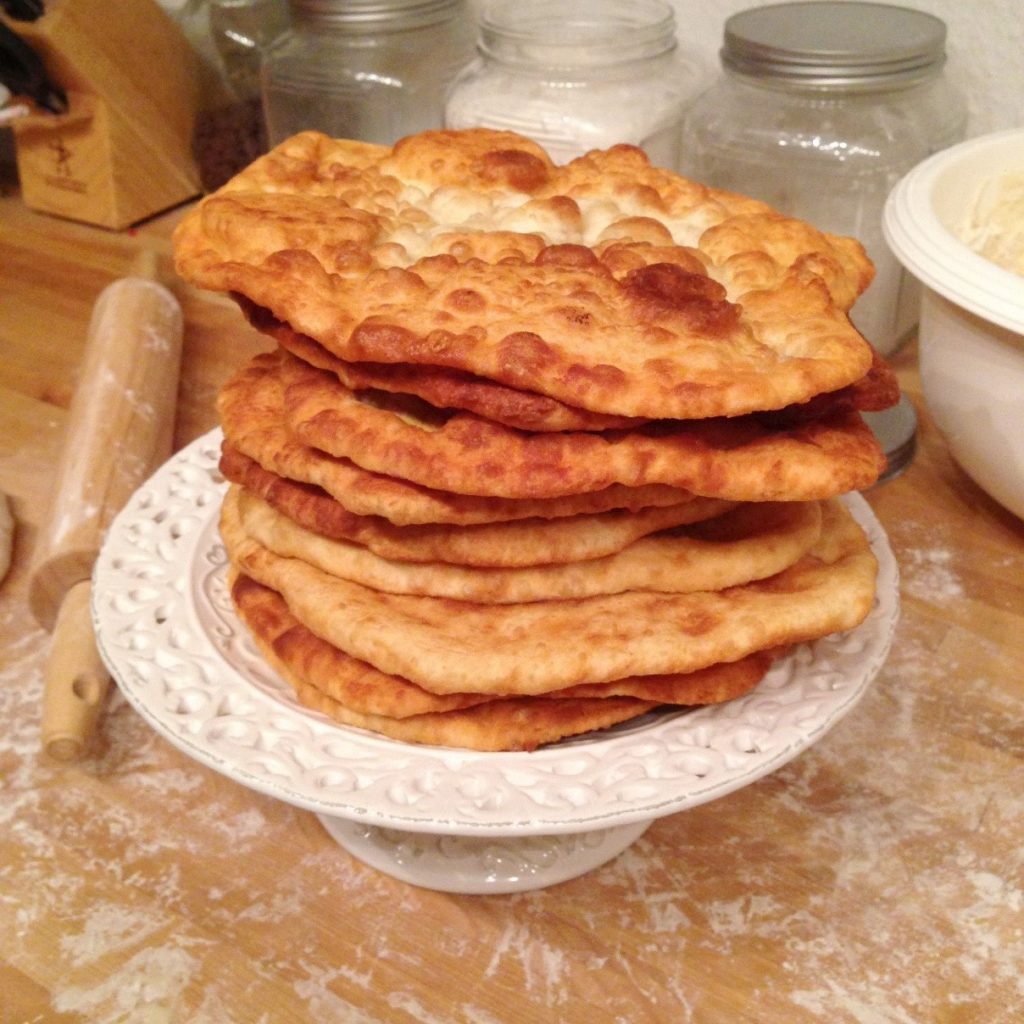
Fry bread is enjoyed by the Navajo and many other native peoples across the continent. It is a staple at community and family events. Its origins date back over 150 years, when native peoples of America were forcibly removed from their ancestral lands. They suddenly found themselves in places that could not sustain their traditional diet. To prevent the indigenous populations from starving, the U.S. government supplied white flour, sugar and lard—the makings of frybread. Since then, frybread has become not only a symbol of native pride, but also an important symbol and remembrance of their survival during their suffering and displacement.
Ingredients
- 6 cups white flour
- 3 tablespoons baking powder
- 1 teaspoon salt (optional)
- 3 ½ cups warm water
Directions
Step 1: Mix dry ingredients together.
Step 2: Add warm water to the mixed dry ingredients. Knead the dough until it is soft and sticks together. Cover and set aside for about 5 minutes.
Step 3: Roll into small balls about 3” each. Pat the ball of dough back and forth with your hands or use a rolling pin. Make sure the edges are evenly thin. Otherwise, it’ll be sticky when you deep fry the flattened dough.
Step 4: Fry in hot vegetable oil in frying pan (between medium and high heat) until golden brown on both sides. Control heat temperature. If there is smoke, the temperature is too high; turn down the heat. Fry for about 1 minute for each side. Could be less if temperature is high.
First Friday of Lent
Gospel Reading | Father Stan Jaszek | Diocese of Fairbanks, Alaska
Father Stan Jaszek, Catholic Extension Society’s 2021-2022 Lumen Christi Award recipient, serves the Yup’ik people in four parishes along the coast of the Bering Sea in the Diocese of Fairbanks, Alaska. Our donors have supported each of these faith communities for many years, and also support his transportation costs as he travels by boat, plane or snowmachine to these extremely isolated villages.
Ahead of the First Friday of Lent, we are sharing the recipe below from the Diocese of Fairbanks, Alaska.
Meatless recipe for First Friday of Lent: Yukon Salmon Fillets
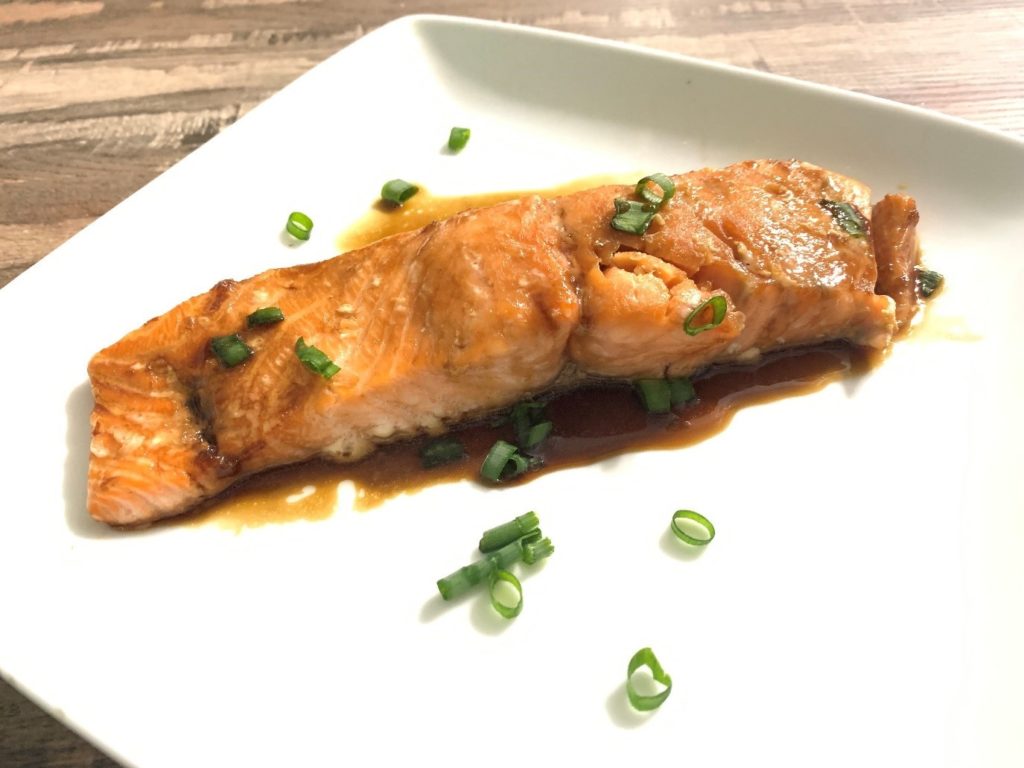
Various species of wild salmon have been at the heart of the Native Alaskan diet for millennia, long before they were dubbed a “superfood” by contemporary nutritionists. Many native villagers in Alaskan villages along the Bering Sea and along the Yukon River continue to rely on their annual catch of salmon for their survival. Traditionally, salmon is smoked and dried to help preserve it for long periods of time. If we eat salmon this Lent, let us be mindful that they are an increasingly fragile species, relying on us to care for the environments that sustain their life, so that they may ultimately exist to sustain ours. As Pope Francis’ says, “we are profoundly united with every creature.” Below is a salmon recipe sourced from a Native Catholic leader in an Alaskan Village.
Ingredients (six servings)
- 6 (6 oz) skinless salmon fillets
- Scallions, sliced for garnish
- Freshly ground black pepper
- 4 teaspoons olive oil
- 4 garlic cloves, minced
- ½ tablespoon ginger root, minced or grated
- 1 ½ tablespoon brown sugar
- 2/3 cup soy sauce
Directions
Step 1: Preheat oven at 375 degrees Farenheit
Step 2: Combine first 7 ingredients for marinade (marinade ingredients start with freshly ground black pepper) in a bowl. Mix well and set aside.
Step 3: Pat-dry the salmon fillets and place in a shallow dish and pour marinade over the salmon. Cover and place in refrigerator to marinade up to 24 hours, if desired.
Step 4: Remove salmon fillets from the refrigerator and allow to rest at room temperature, about 10 minutes.
Step 5: Bake in the oven uncovered for 25 minutes or until meat is flaky but not dry.
Step 6: Garnish with sliced scallions. Serve immediately.
Ash Wednesday
Gospel Reading | Father Rob Adams | Diocese of Lexington, Kentucky
Father Rob Adams is the pastor at St. Francis of Assisi Church, located in the Eastern Kentucky Appalachian Mountains where less than 0.5 percent of the population is Catholic. Their hillside church, constructed in 1949 in Pikeville, Kentucky, was deteriorating. Thanks to the support of our donors, a new church was built for the parish and dedicated in May 2015.
Today, Father Adams leads this parish and St. George Church in Jenkins, traveling 31 miles between the two Appalachian faith communities. He serves a region where the Catholic Church is powerfully living its mission in spite of many challenges.
Ahead of Ash Wednesday, we are sharing two recipes from the Diocese of Lexington, Kentucky.
Meatless recipe for Ash Wednesday: Soup Beans
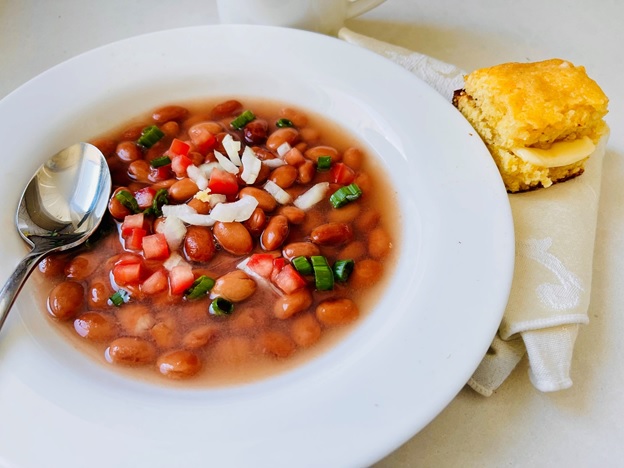
The Appalachian region stretches for 1,000 miles across many states and its cuisine is as diverse as the immigrants, natives and settlers who have populated the region over its history. Two things that traditional dishes from this region tend to have in common is that they are centered around locally sourced ingredients with a winterproof shelf life, such as canned vegetables, beans, and grains. Below is a bean soup recipe provided by a Catholic community in Appalachia to fill your Lent with some warmth and some satisfying protein.
Ingredients
- 16 ounces dry pinto beans
- 1 diced onion
- 2 cloves minced garlic
- 4 cups water
- 4 cups vegetable broth
- ½ teaspoon ground cumin
- 1 teaspoon smoked paprika or liquid smoke
- Salt and pepper to taste
Directions
Step 1: Sort through the beans. Rinse well and place in a large pot. Add enough water to cover the beans. Let soak overnight.
Step 2: Drain and rinse beans well. Return to pot.
Step 3: Add onion, garlic, water, broth, cumin, and smoked paprika.
Step 4: Bring to a boil. Reduce heat to a simmer and cover.
Step 5: Beans should be tender in 3-4 hours. Check periodically to make sure there is still plenty of liquid. Add broth/water as necessary.
Step 6: After beans are tender, season with salt and pepper.
Step 7: Serve with corn bread, diced onions, chow chow relish, etc.
Meatless recipe for Ash Wednesday: Buttermilk Pie
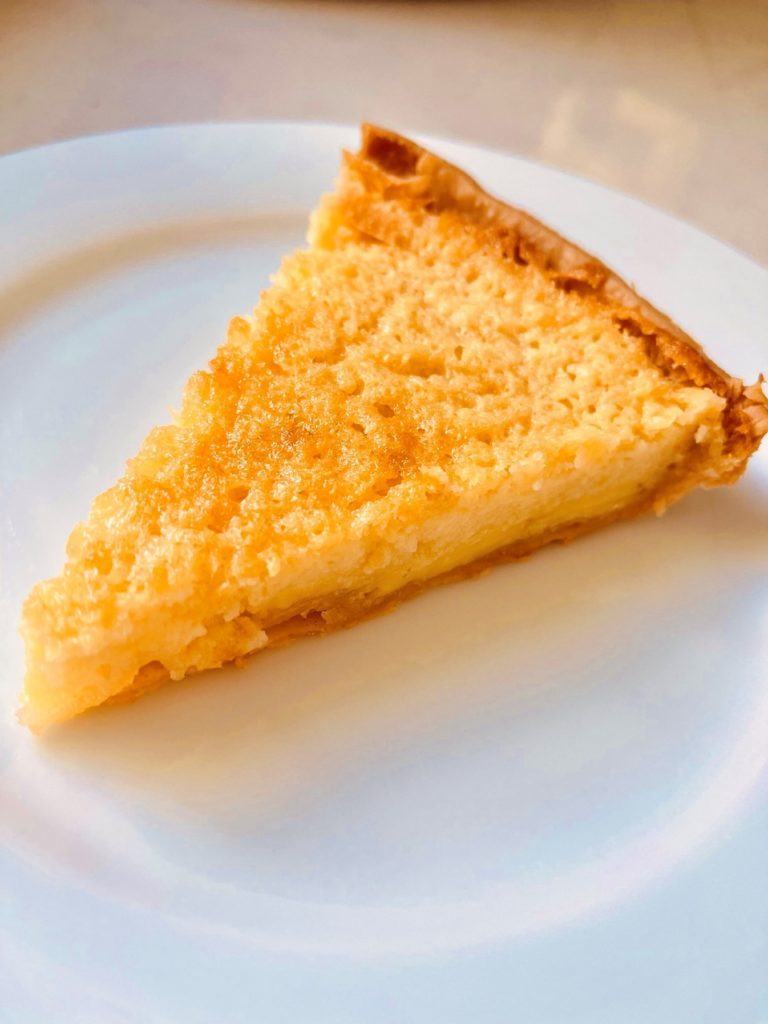
Buttermilk pie falls into the special genre of pastries called “desperation pies” that have emerged from the southern U.S. states. These pies were developed using only staple ingredients that are affordable or available even in the worst economic times. While these pies are a reflection of economic distress, they are also a symbol of people’s unique ability to make do with what they have and create memorable and desirable dishes even without luxury or expensive ingredients. Therefore, this buttermilk pie recipe represents, perhaps, an opportunity to be in solidarity with the poor this Lenten season, particularly our brothers and sisters in the Appalachian region who have shared this recipe with us.
Ingredients
- 3 eggs
- 1 ½ cups white sugar
- ½ cup butter, softened
- 3 tablespoons all-purpose flour
- 1 cup buttermilk
- 1 tablespoon lemon juice
- 1 teaspoon vanilla extract
- 1 (9 inch) unbaked pie crust
Directions
Step 1: Preheat oven to 350 degrees.
Step 2: Beat eggs until frothy. Add butter, sugar and flour. Beat until smooth.
Step 3: Sit in buttermilk, lemon juice and vanilla. Pour into pie shell.
Step 4: Bake for 40-60 minutes, or until center is firm.
The Live the Lenten Journey series is part of our Thriving Congregations Initiative, made possible through support from Lilly Endowment Inc.


